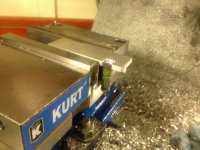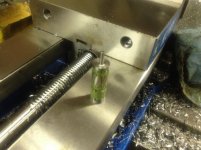aarongough
Stainless
- Joined
- Oct 27, 2014
- Location
- Toronto, Canada
Hey guys!
Someone local is selling a very clean looking yr2000 HAAS VF-0B, and I'm wondering whether this machine would be an upgrade over my current machine, which is a 1994 Fadal VMC10.
The Fadal is DC servo, looks like the HAAS is AC servos.
My main concern is the relative quality of 3D surfacing that both machines would be capable of.
My Fadal overall runs great, but I am very aware that I'm up against the limits of what it's capable of in terms of 3D machining. I do a lot of 3D surfacing of hardened tool steel (the Fadal runs 40-50 hours a week cutting A2 @ 63HRC) and I have to slow my lead-in moves to 3IPM on the Fadal in order to stop it overshooting in Z- when starting each pass when doing parallel finishing.
I also get some 'banding' when finishing very shallow angled surfaces on the Fadal, it looks like I'm running into a resolution issue with the machine as the 'bands' or 'steps' (small though they are) are at regular intervals and at the exact same places on every part.
I'm very curious as to whether the HAAS is likely to be better in terms of the finishes it's capable of?
Thanks in advance!
-Aaron
Someone local is selling a very clean looking yr2000 HAAS VF-0B, and I'm wondering whether this machine would be an upgrade over my current machine, which is a 1994 Fadal VMC10.
The Fadal is DC servo, looks like the HAAS is AC servos.
My main concern is the relative quality of 3D surfacing that both machines would be capable of.
My Fadal overall runs great, but I am very aware that I'm up against the limits of what it's capable of in terms of 3D machining. I do a lot of 3D surfacing of hardened tool steel (the Fadal runs 40-50 hours a week cutting A2 @ 63HRC) and I have to slow my lead-in moves to 3IPM on the Fadal in order to stop it overshooting in Z- when starting each pass when doing parallel finishing.
I also get some 'banding' when finishing very shallow angled surfaces on the Fadal, it looks like I'm running into a resolution issue with the machine as the 'bands' or 'steps' (small though they are) are at regular intervals and at the exact same places on every part.
I'm very curious as to whether the HAAS is likely to be better in terms of the finishes it's capable of?
Thanks in advance!
-Aaron






